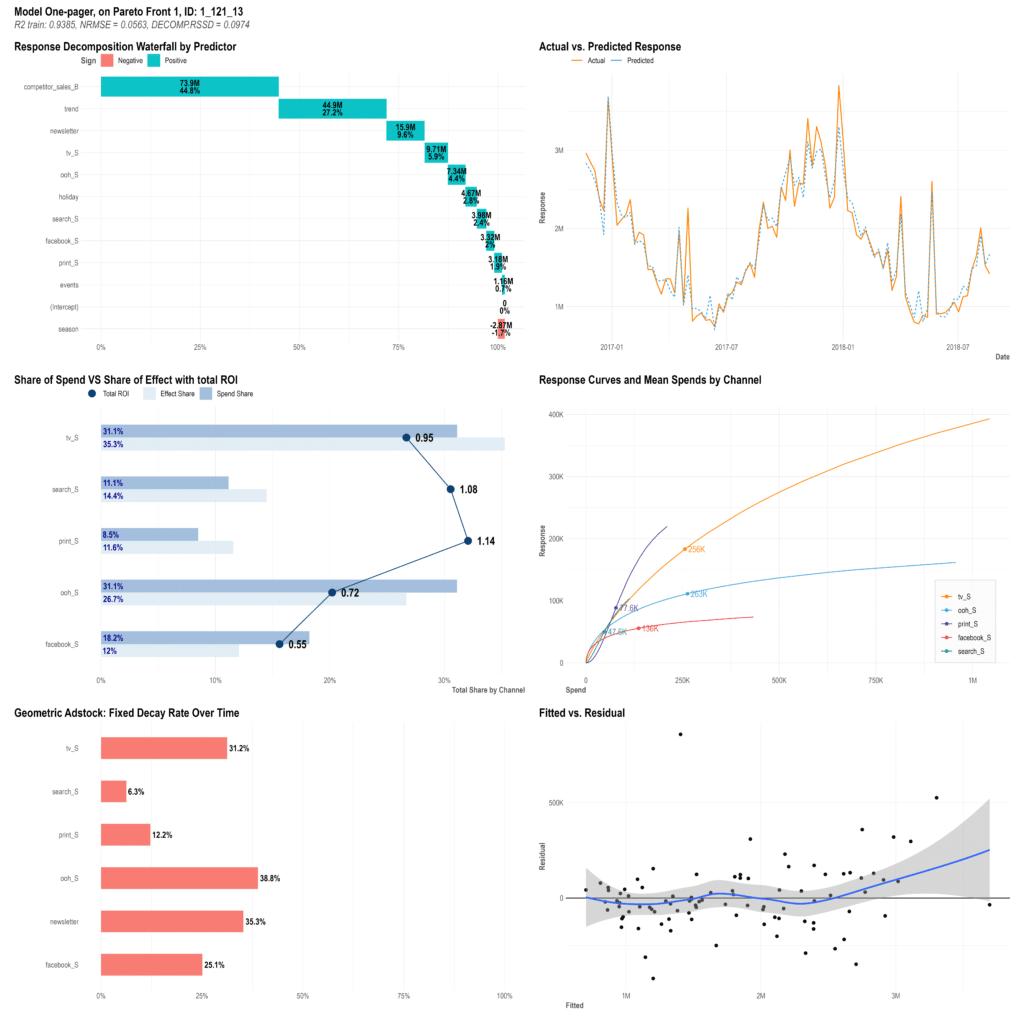Experiences refined for people
Experiences refined for people
The power of Media Mix Modeling (MMM) cannot be underestimated. As marketers strive to reach their target audiences through various channels and platforms, understanding the impact of different media channels is crucial.
In this article, we’ll review what MMM is, how it works, and why it should be a vital part of advertising campaign optimization.
Media mix modeling, or marketing mix modeling, is an analytical technique that measures the impact of each marketing channel on sales and guides the optimal resource allocation.
There are three goals with MMM:
With MMM, you can identify which elements of your advertising work and which don’t, allowing you to make informed adjustments and optimize your campaign for better results.
“Half the money I spend on advertising is wasted; the trouble is–I don’t know which half.”

Media mix modeling can be used for a variety of industries and marketing purposes. Some popular ways include:
Media mix modeling can help you determine how to best use your marketing budget across different channels and strategies. It can determine the most effective channels for your specific goals.
Example: If you want to increase your brand’s awareness, MMM can tell you the best way to do that, whether through TV advertisements, online display ads, social media campaigns, or a combination of these channels.
Media mix modeling uses historical data to quantify each marketing channel’s impact on key performance indicators (KPIs) like sales, website traffic, and customer engagement. These insights refine marketing strategies and optimize resource allocation for maximum impact.
Example: For a fictional university, media mix modeling revealed that increasing investment in social media advertising by 20% resulted in a 15% boost in website traffic and a 10% increase in overall sales.
Media mix modeling empowers marketers to make data-driven decisions for future campaigns by simulating different marketing scenarios and their impact. This can help you optimize strategies and anticipate potential outcomes on business performance.
Example: For the same fictional university, media mix modeling’s forecasting revealed that increasing their marketing spend on paid social advertising in the summer months would give them the best ROI than spending on paid social in the winter months.
Measuring ROI is more complicated than checking that metric on the report broken up by media channel.
Here’s why:
Customers interact with your brand through different platforms like CTV, radio, online ads, social media, and more.
Each touchpoint plays a vital role in influencing the customer’s decision-making process and eventual purchase decision. Understanding each channel’s impact on the overall ROI becomes challenging when the influences overlap.
Also, external factors on sales, including seasonality, world events, market trends, and more, can affect sales. Media Mix Modeling (MMM) enables us to identify these positive or negative trends and optimize relevant channels’ return on investment (ROI) by adjusting spending accordingly.
Example: Utilizing MMM, you could uncover the value in increasing spending on TV ads during the COVID-19 pandemic when people stayed home.
Determining the precise contribution of each media channel to the final ROI requires advanced analytical techniques like media mix modeling.
What is one of the biggest benefits of Marketing/Media Mixed Modeling (MMM)?
“Amidst seismic privacy changes and digital ad tracking shifts, accurately assessing digital performance has become challenging for marketers. Digital marketing now resembles traditional offline marketing in terms of measuring a campaign’s direct impact.
Marketing mix modeling helps to address the measurement limitations for both online and offline marketing in a scientifically sound and easy-to-understand manner. Fortunately, MMM technology, tools, and resources are now more accessible and affordable. Brands no longer need to spend exorbitant amounts with MMM companies for valuable insights.”

Purchasing influence from offline media like pDOOH (programmatic digital out of home), magazines, and radio is difficult to track. Unlike digital platforms, where we can monitor click-through rates and impressions, the visibility and reach of offline media remain somewhat elusive.
Also, privacy regulations like the General Data Protection Regulation (GDPR) and Apple’s Identifier for Advertisers (IDFA) deprecation restrict the collection and use of personal data for targeted advertising. This hampers advertisers in tracking user behavior, attributing conversions to specific campaigns or channels, and gaining precise insights into campaign success.
MMM uses historical data and statistical modeling to provide a holistic view of online and offline media channel effectiveness, even in cases where direct tracking is challenging.
Randomized experiments (known as Lift Tests) can help reveal a campaign’s effectiveness.
However, in practice, it is often difficult for companies to implement such experiments for an extended period. This is because companies are hesitant to restrict their advertisements for too long, which may lead to missed opportunities for reaching potential customers.
As a result, alternative methods like media mix modeling are used to assess the impact of advertising without the need for prolonged experiments.
Media mix modeling uses multi-linear regression analysis to highlight the relationship between sales or conversions and ad spending.
Multi-linear regression in MMM links an independent variable (the predictor) to a dependent variable (the outcome or response).
In simple terms, an independent variable is something we change or control in an experiment or study. It’s a factor that we think can influence the outcome we’re interested in, called the dependent variable.
Example: Different media channels used (TV, radio, online ads) in an advertising campaign.
A dependent variable is a result or response that we measure or observe. It’s the outcome we’re interested in, and we expect it to be influenced by changes in the independent variable.
Example: Sales revenue generated, website traffic, or brand awareness levels influenced by the different media channels.
You can use MMM to measure how an independent variable (e.g., in-app downloads) affects the dependent variable (e.g., total revenue) and then analyze “what if” scenarios like how much you would earn or lose if you increase spending on these ads.
✨ An Example of MMM in Action ✨
Threadz, a fictional global retail brand, used Media Mix Modeling (MMM) to analyze three years of historical data on various marketing channels (CTV, display, paid search) and their respective contributions to overall revenue.
The analysis revealed that CTV ads contribute 40%, display ads account for 20%, and paid search campaigns drive 15%. Informed by these insights, Threadz reallocates its budget, increasing CTV ad investment by 10% and reducing paid search spend by 5%.
MMM predicts that these adjustments will lead to a projected 12% increase in revenue, from $50 million to $56 million.
Using multiple linear regression, MMM identifies the quantitative relationship between the advertising spend and the resulting sales or conversions.
The new wave of MMM is powered by machine learning. A lot of the traditional work involved in executing MMM is done by machine learning and automation.
Machine learning algorithms can analyze vast amounts of data and identify complex relationship patterns and interactions between different variables, providing even deeper insights into the impact of marketing efforts on business outcomes.
We collect historical data, typically spanning two to three years, including information on our marketing activities, such as advertising expenditure on different media channels, user engagement metrics, and business outcomes, like sales or conversion data.
We use various data types, including First-Party data, collected directly from your own audience. The most important data we need is the key performance indicator (KPI). Sales is a common KPI for retailers or manufacturers.
We also consider various factors that can influence sales as explanatory variables. These include media data like advertising channels and non-media marketing data like pricing, promotions, and product distribution. External factors like seasonality, holidays, weather, and the overall economy are considered to improve the model’s accuracy.
Then, we organize and clean the data, ensuring it is accurate, consistent, and suitable for analysis.
The multi-linear regression model is built by analyzing the sales or conversion data as the outcome we want to understand and the marketing channel variables as the factors we want to study.
We select the dependent variables (e.g., revenue or conversions) that we want to explain and identify the independent variables (e.g., marketing channels or ad spend) that impact the dependent variable.
💡 We consider controllable variables like price and channel and uncontrollable variables like competition and inflation.
Behind the scenes, the algorithm calculates coefficients for each marketing channel, showing how they affect the outcome. Coefficients are numbers that tell us how much each marketing channel influences sales or conversions.
Positive coefficients mean investing more in a specific channel leads to higher sales, while negative coefficients mean investing more in a channel could lower sales. The bigger the coefficient, the stronger the effect of that channel on sales.
Example: After analyzing data, the model reveals the following coefficients: TV ads (+0.6), online display ads (+0.4), paid search campaigns (+0.3), social media promotions (+0.2), and email marketing (+0.1).
These coefficients indicate each channel’s strength and direction of influence on sales. For example, the +0.6 coefficient for TV ads indicates that increasing investment in TV advertising will likely lead to a 0.6 times increase in sales.
A negative coefficient (e.g., -0.2) suggests increasing investment in a particular channel may decrease sales.
In this stage, we analyze insights related to your marketing campaigns and evaluate how each marketing channel contributes to the desired business outcomes and metrics we identified earlier.
The algorithm from the MMM tool reveals only what is statistically significant and presents only the best models to us.
This is an example of the output we get:

We’ll take the data from the output result to determine the best-fit model for your business.
Although we can also use the model to forecast future outcomes, models based on historical data assume that past patterns will continue and may not account for changes in the marketing landscape.
With the insights gained from the regression analysis, we can help you optimize your media budgets by identifying the channels with the highest impact on sales and reallocating resources accordingly.
This helps maximize the return on investment (ROI) and improve your campaigns’ success.
Media mix modeling and data-driven attribution models help determine the impact of marketing tactics on a business’s objective. Both use statistical and mathematical models to analyze data.
The difference lies in what they measure.
MMM generates a 500-foot view of your company’s marketing tactics and performance over time but doesn’t provide a more granular view of a customer journey through the sales funnel.
Data-driven attribution modeling provides that personal-level view by monitoring user-level engagements throughout the customer journey, like total impressions or clicks.
Both are complementary and provide different insights to help you optimize your marketing efforts.
MMM is time-consuming, so alternative approaches like data-driven attribution may be more suitable if your campaign is time-sensitive. Or you can ask an experienced marketing agency to help.
With our expert team, we’ll make sure your ad dollars are going to all the right strategies.
Wei Oo is a Software Engineer at KORTX. He’s also a dad who enjoys sleeping.
From us to your inbox weekly.